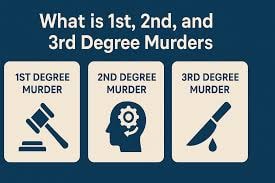business-services

August 14,2025 • 4 min read
Different Degrees of Murder: Eye-Opening Cases

Introduction
When we hear the word “murder,” our minds often jump straight to the most extreme version—a cold, calculated killing. But in the eyes of the law, not all murders are the same. In fact, the legal system recognizes different degrees of murder, each with its own definition, penalties, and impact on sentencing.
The difference between first-degree murder and second-degree murder can determine whether someone spends decades in prison, faces the death penalty, or has the possibility of parole. These classifications aren’t just legal jargon—they affect real people, in real cases, with life-changing consequences.
In this guide, we’ll break down the degrees of murder and bring them to life with eye-opening cases that show how these legal distinctions play out in court.
What Does “Degrees of Murder” Mean?
The term “degrees of murder” refers to how the law categorizes killings based on intent, planning, and the circumstances of the crime. This classification ensures that punishment is proportionate to the severity of the act.
First-Degree Murder – Cold, Calculated, and Intentional
Definition:
First-degree murder is the most serious homicide charge, reserved for killings that are both intentional and premeditated.
Legal Elements:
-
Premeditation – The decision to kill is made before the act.
-
Deliberation – Careful thought, not impulse.
-
Malice aforethought – Clear intent to kill or cause great harm.
Eye-Opening Case:
In 2012, Jodi Arias was convicted of first-degree murder for killing her boyfriend, Travis Alexander, in Arizona. Evidence showed she planned the attack in advance, including bringing a weapon and attempting to cover her tracks. The court found premeditation, leading to a life sentence without parole.
Typical Penalties:
-
Life in prison without parole.
-
Death penalty (in states where it’s allowed).
Second-Degree Murder – Intent Without Planning
Definition:
Second-degree murder happens when a killing is intentional but not premeditated. Often, it results from a sudden outburst of violence.
Legal Elements:
-
No prior planning.
-
Intent forms during the event.
-
Reckless disregard for human life.
Eye-Opening Case:
In 2007, NFL player Rae Carruth was convicted of conspiracy and second-degree murder in the death of his pregnant girlfriend. The killing was not proven to be preplanned to the legal standard of first-degree murder, but his actions showed clear intent once events unfolded.
Typical Penalties:
-
15 years to life in prison.
-
Sentence length depends on the state and aggravating factors.
Third-Degree Murder – Recklessness with Fatal Consequences
Not all states recognize third-degree murder, but in those that do (like Pennsylvania and Minnesota), it refers to deaths caused by reckless actions without intent to kill.
Eye-Opening Case:
In 2021, former Minneapolis police officer Derek Chauvin was found guilty of third-degree murder for the killing of George Floyd. The charge was based on acting with a “depraved mind” without regard for human life.
Typical Penalties:
-
Up to 40 years in prison (state laws vary).
Manslaughter – A Separate but Related Charge
Manslaughter is less severe than murder but still a serious felony. It comes in two main forms:
-
Voluntary Manslaughter – Killing in the heat of passion after strong provocation.
Example: A person finds their spouse with someone else and reacts violently without time to cool off. -
Involuntary Manslaughter – Accidental killing from reckless or negligent behavior.
Example: A drunk driver hits and kills a pedestrian.
Conclusion
Understanding the different degrees of murder isn’t just about knowing legal definitions—it’s about seeing how justice is applied in the real world. From first-degree murder’s calculated brutality to the reckless disregard seen in third-degree cases, each classification tells a story about the crime, the criminal, and the victim.
These eye-opening cases remind us that intent, planning, and circumstance can mean the difference between life in prison and a lighter sentence. Whether you’re following a high-profile trial or studying criminal law, knowing these distinctions offers valuable insight into how our justice system works.
parag agrawal Details
User Profile
- Full name
- parag agrawal
- Email address
- paragagrawal373@gmail.com
- Join Date
- 2025-08-14
- State
- City
- Pincode
- Address
- Follow us on Facebook
- Follow us on Twitter
- Website Name
- Bio